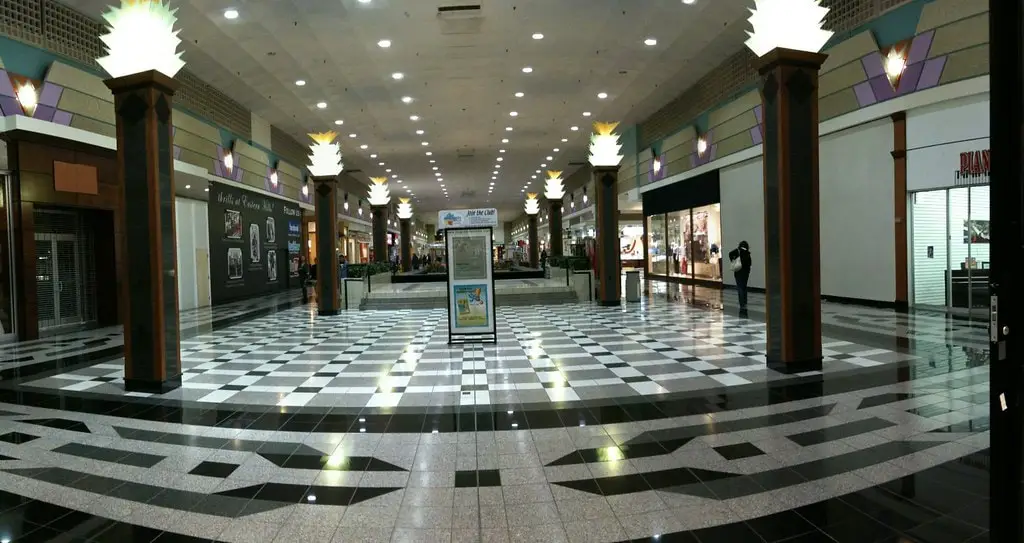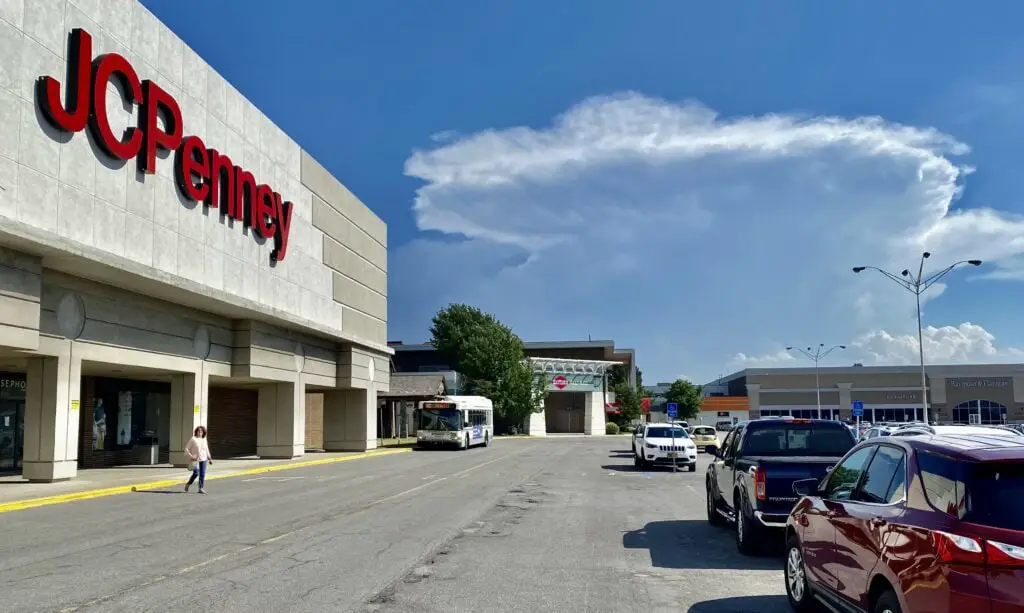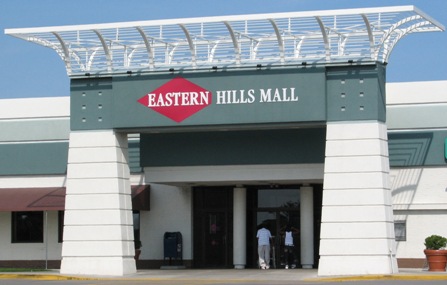The Dawn of Eastern Hills Mall
In the early 1970s, the retail landscape near Buffalo, NY, was forever changed with the opening of the Eastern Hills Mall.
This commercial venture, developed by the Edward J. DeBartolo Corporation, marked a significant evolution in shopping and leisure, setting a new standard for the region’s retail experience.
Initially proposed to be named “Buffalo Mall,” the name was changed to Eastern Hills Mall at the request of the town of Clarence, reflecting its geographical location and the gentle hills that characterize the area.
The mall officially opened on November 8, 1971, introducing a sprawling complex that would become a cornerstone of community life and commerce.
From the outset, Eastern Hills Mall was designed to be more than just a shopping center; it was a destination.
With an impressive lineup of anchor stores, including Sears, JCPenney, Woolworths, AM&A’s, Jenss, and Hengerer’s, the mall offered a diverse range of products and services, catering to the needs and preferences of a wide audience.
This variety attracted shoppers across the region and set the stage for the mall’s role as a community hub.
Adding to the mall’s appeal was the Eastern Hills Cinema, which opened approximately six months after the mall on May 24, 1972.
This addition brought a new dimension to the mall, entertaining shopping and making it a perfect spot for things to do in Buffalo, NY.
The cinema, alongside the diverse retail offerings, underscored the mall’s commitment to providing a comprehensive experience for visitors.
The choice of the mall’s location on Transit Road, near the junction of NY-78 with NY-5 and Main Street, was strategic.
It placed the mall at the heart of a growing commercial strip, ensuring easy access for shoppers and positioning Eastern Hills as a central player in the region’s retail landscape.
The name “Eastern Hills” itself, derived from the area’s slightly elevated terrain along the Onondaga Escarpment, highlighted the unique geographic features that added to the mall’s identity.
Evolution Through Decades
Eastern Hills Mall’s journey through the years is a story of adaptation and change, reflecting the evolving retail and consumer preferences landscape.
The first significant transformation came in 1987, nearly two decades after its opening.
This overhaul introduced a food court, enhancing the mall’s appeal by offering various dining options to shoppers seeking a break from their retail adventures.
This addition was not just about food; it was about creating a social space within the mall, encouraging visitors to stay longer and enjoy their time beyond shopping.
The mall’s physical layout and tenant mix changed further over the years.
Notably, the mall sought to expand its offerings by planning for a Lechmere store next to JCPenney.
However, this expansion has yet to come to fruition.
Despite this, Eastern Hills continued to evolve, responding to the shifting dynamics of the retail industry and the needs of its customers.

The late 1980s and early 1990s were particularly transformative.
Eastern Hills lost its title as the largest mall in the Buffalo area to the Walden Galleria in 1989, a shift that signaled changing consumer habits and the competitive nature of retail.
Anchor stores underwent several transitions: Sibley’s replaced Hengerer’s in 1981, only to become Kaufmann’s in 1990.
AM&A transformed into The Bon-Ton in 1994, reflecting the broader trends of consolidation and rebranding in the department store sector.
These changes were more than mere name swaps; they represented the mall’s ongoing efforts to stay relevant and appealing to its customer base.
The 21st Century and Digital Competition
Entering the 21st century, Eastern Hills Mall faced new challenges as digital retail reshaped the shopping landscape.
The rise of online shopping platforms offered convenience and a breadth of options that traditional brick-and-mortar stores needed to match.
This shift in consumer behavior profoundly impacted malls across the country, and Eastern Hills was no exception.
The mid to late 2010s marked a significant transition for the mall’s anchor stores, reflecting the retail industry’s broader struggles.
In April 2016, Macy’s announced its departure from Eastern Hills, choosing to focus on its higher-performing locations as part of a strategic consolidation effort.
This move was symbolic of the challenges faced by traditional department stores, which were increasingly losing ground to online competitors.
The following years saw further departures.
The Bon-Ton closed its doors in April 2018 after failing to find a sustainable path forward amidst mounting debt.
Sears followed suit, announcing its closure in December 2018 as part of a broader effort to scale back its physical presence.
These exits underscored the changing dynamics of retail, where even established players needed help to adapt to the rapidly evolving market.
Despite these challenges, Eastern Hills Mall sought to reinvent itself, exploring new ways to attract visitors and remain a viable destination in the age of digital retail.
The departure of traditional anchors opened space for a more diverse mix of tenants, including smaller, local businesses and non-traditional uses that breathed new life into the mall’s corridors.
This period highlighted the mall’s resilience and efforts to adapt to a retail environment.

A Hub of Community and Non-Commercial Activity
Eastern Hills Mall extended its role beyond retail to become a vital community hub, which was especially evident after the October Storm of 2006.
This natural disaster brought significant disruption to the area.
Still, the mall’s parking lot emerged as a critical point for recovery efforts.
Utility companies utilized this expansive space as a staging area, parking their vehicles overnight and coordinating restoration work during the day.
Additionally, part of the lot served as a storage area for materials essential for power restoration, highlighting the mall’s contribution to the community in times of need.
The mall’s significance as a community center was wider than emergency responses.
Over the years, Eastern Hills became a venue for various non-commercial activities that brought people together.
From charity events to local gatherings, the mall provided a space where the community could engage in activities beyond shopping.
This aspect of the mall underscored its importance not just as a commercial entity but as a social and communal space integral to the fabric of the surrounding area.
The Transition to a Mixed-Use Development
The retail and community spaces landscape has been transforming, with a growing emphasis on mixed-use developments that combine residential, commercial, and recreational facilities.
Eastern Hills Mall is at the forefront of this shift, with its redevelopment into a “lifestyle shopping center.” This vision is spearheaded by Uniland Development, in partnership with Mountain Development Corp., aiming to repurpose the mall into a vibrant, walkable community hub.
In March 2018, Uniland Development acquired a stake in the mall, setting the stage for an ambitious redevelopment project.
The Clarence Town Board approved the plans in August 2018, signaling community support for the transformation.
The project envisions a blend of residential apartments, retail spaces, restaurants, and green areas designed to create a dynamic environment that responds to contemporary lifestyle preferences.

The design and planning phase involved collaboration with Gensler, a renowned architecture firm with experience creating upscale shopping and mixed-use developments.
The first updates to the redevelopment plan were unveiled in March 2020, with a proposal submitted to Clarence town officials in June 2021.
This redevelopment aims to revitalize the mall and redefine it as a central gathering place that meets the community’s evolving needs, blending the convenience of urban living with the appeal of suburban accessibility.
The Final Days and Community Reflections
On January 10, 2024, the announcement that Eastern Hills Mall would close its interior sections marked the end of an era for a beloved community landmark.
This decision was part of a broader plan to transition the space into a new mixed-use development.
Stores without external entrances were given eviction notices, with a deadline to vacate by January 14, 2024.
This move paved the way for the partial demolition of the mall, a necessary step in its transformation.
The closure stirred a wave of nostalgia among the mall’s patrons, many of whom had grown up with Eastern Hills as a backdrop to their lives.
Memories of first jobs, family outings, and teenage rendezvous filled social media and local news outlets, highlighting the mall’s role as a shopping center and a repository of communal memories.
The mall’s final days were characterized by a bittersweet atmosphere, with visitors coming to say their goodbyes, taking one last walk through the familiar corridors, and reminiscing.
Despite the sadness associated with its closure, the move was also met with understanding and anticipation for the future.
The community recognized the need for change and the potential benefits of the new development.
The end of the Eastern Hills Mall in its original form was seen as a step towards a new chapter in the area’s evolution, promising to bring new life and energy to the space.
The Next Chapter for Eastern Hills Mall
Uniland Development has initiated the next steps in redeveloping Eastern Hills Mall in Clarence.
This development marks a pivotal moment for the mall, transitioning from its traditional role as a retail hub to becoming the Eastern Hills Town Center.
This ambitious project aims to transform the 100-acre site into a vibrant mix of office, medical, residential, shopping, dining, entertainment, recreational, and hospitality spaces.
The mall, a long-standing fixture in Clarence and Williamsville, is set to embrace this change to meet evolving consumer preferences and the shifting retail landscape.
The redevelopment plan includes maintaining certain retailers with exterior access, ensuring they continue serving the community during and after the transformation.
These include popular spots like Duff’s Famous Wings, Lox Salon, Sto Lat Bar and Event Center, Chrusciki Bakery, and others, including JC Penney and Orvis.
Additionally, some retailers have been relocated within the mall to provide them with exterior access, facilitating a seamless transition as the redevelopment progresses.
The vision for the Eastern Hills Town Center is not just about retail and commercial opportunities; it’s about creating a new regional destination that offers something unique to residents and visitors.
The project promises to redefine the area’s landscape with plans for approximately 1,500 residential units and one million square feet of office and medical space alongside multiple restaurants, retail stores, and hotels.
This redevelopment is a testament to the adaptability and resilience of the local community and a forward-looking endeavor that seeks to redefine what a mall can be in the 21st century.
Looking Forward
As Eastern Hills Mall transitions from a traditional retail hub to a mixed-use lifestyle center, the focus shifts to the future and what this development means for the community.
The project, spearheaded by Uniland Development and Mountain Development Corp., is a significant investment in the area’s growth and revitalization.
The new development aims to create a vibrant, walkable community that aligns with modern living preferences by incorporating residential units, retail spaces, dining options, and recreational areas.
The plans for the mixed-use development have sparked interest and optimism among residents and businesses.
Including green spaces and community areas is particularly welcomed, as it promises to enhance the quality of life for those living and working there.
Moreover, the project is expected to attract new businesses and residents, contributing to the region’s economic vitality.
As the community looks forward to the completion of this ambitious project, there is a sense of anticipation for the positive changes it will bring.
The transformation of Eastern Hills Mall into a lifestyle shopping center represents a forward-thinking approach to urban development.
This redevelopment is not just about building structures; it’s about creating a community-focused environment that will serve as a model for future regional and beyond projects.
